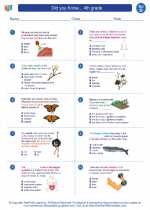Did you Know... 4th grade -> transport
Transport
Transport refers to the movement of materials and substances from one place to another. In the world of science, transport can occur on various scales, from the movement of molecules within a cell to the circulation of water and nutrients in plants and animals. Understanding the different types of transport is essential for comprehending how living organisms function and how materials move throughout the environment.
Types of Transport
There are several types of transport that occur in living organisms and the natural world. These include:
- Passive Transport: This type of transport does not require energy and occurs through processes such as diffusion, osmosis, and facilitated diffusion. Molecules move from areas of high concentration to low concentration.
- Active Transport: Active transport requires energy, usually in the form of ATP (adenosine triphosphate). This process allows molecules to move against their concentration gradient, from areas of low concentration to high concentration.
- Plant Transport: In plants, transport occurs through the processes of transpiration, which involves the movement of water through the plant, and translocation, which involves the movement of sugars and other nutrients through the phloem.
- Animal Transport: Animals have specialized systems for transport, including the circulatory system for the distribution of oxygen, nutrients, and waste products, and the respiratory system for the exchange of gases.
Study Guide for Transport
Key Concepts
- Understand the difference between passive and active transport.
- Explain the processes of diffusion, osmosis, and facilitated diffusion.
- Describe the mechanisms of plant transport, including transpiration and translocation.
- Identify the components and functions of the circulatory and respiratory systems in animals.
Study Tips
- Use diagrams and visual aids to understand the movement of molecules and substances during transport processes.
- Practice with real-life examples of transport, such as the movement of water through a plant or the uptake of nutrients in the human digestive system.
- Compare and contrast different types of transport to deepen your understanding of the topic.
- Review the role of cell membranes in controlling the movement of materials during transport.
Review Questions
- What is the difference between passive and active transport?
- How does osmosis differ from diffusion?
- Explain the role of the circulatory system in animal transport.
- What are the two main processes involved in plant transport?
- Why is the movement of materials through cell membranes crucial for cellular function?
By mastering the concepts and processes of transport, you will gain a deeper understanding of how living organisms maintain essential functions and how materials move through natural systems.
.◂Science Worksheets and Study Guides Fourth Grade. Did you Know... 4th grade

 Worksheet/Answer key
Worksheet/Answer key
 Worksheet/Answer key
Worksheet/Answer key
 Worksheet/Answer key
Worksheet/Answer key
